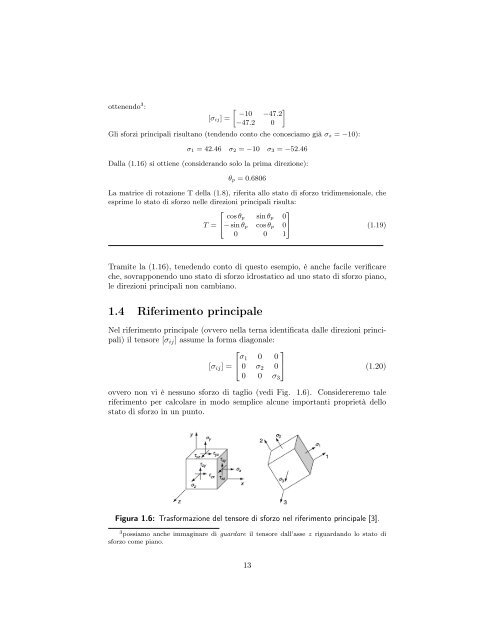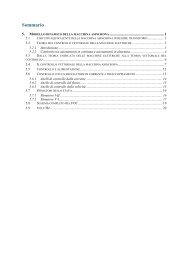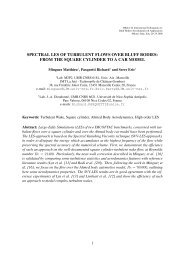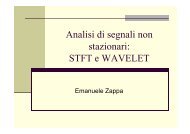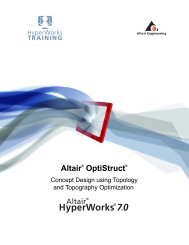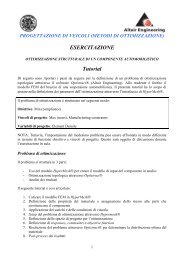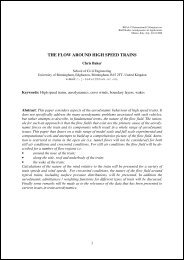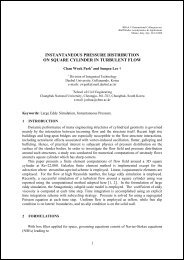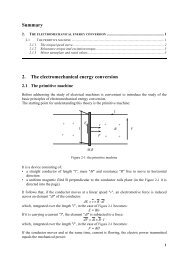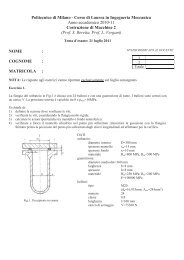Dispense del corso (aggiornate al 10 giugno 2012) - Costruzione di ...
Dispense del corso (aggiornate al 10 giugno 2012) - Costruzione di ...
Dispense del corso (aggiornate al 10 giugno 2012) - Costruzione di ...
You also want an ePaper? Increase the reach of your titles
YUMPU automatically turns print PDFs into web optimized ePapers that Google loves.
ottenendo 3 :[σ ij] =[ −<strong>10</strong>] −47.2−47.2 0Gli sforzi princip<strong>al</strong>i risultano (tendendo conto che conosciamo già σ z = −<strong>10</strong>):σ 1 = 42.46 σ 2 = −<strong>10</strong> σ 3 = −52.46D<strong>al</strong>la (1.16) si ottiene (considerando solo la prima <strong>di</strong>rezione):θ p = 0.6806La matrice <strong>di</strong> rotazione T <strong>del</strong>la (1.8), riferita <strong>al</strong>lo stato <strong>di</strong> sforzo tri<strong>di</strong>mension<strong>al</strong>e, cheesprime lo stato <strong>di</strong> sforzo nelle <strong>di</strong>rezioni princip<strong>al</strong>i risulta:⎡cos θ p sin θ p⎤0T = ⎣− sin θ p cos θ p 0⎦ (1.19)0 0 1Tramite la (1.16), tenedendo conto <strong>di</strong> questo esempio, è anche facile verificareche, sovrapponendo uno stato <strong>di</strong> sforzo idrostatico ad uno stato <strong>di</strong> sforzo piano,le <strong>di</strong>rezioni princip<strong>al</strong>i non cambiano.1.4 Riferimento princip<strong>al</strong>eNel riferimento princip<strong>al</strong>e (ovvero nella terna identificata d<strong>al</strong>le <strong>di</strong>rezioni princip<strong>al</strong>i)il tensore [σ ij ] assume la forma <strong>di</strong>agon<strong>al</strong>e:⎡⎤σ 1 0 0[σ ij ] = ⎣ 0 σ 2 0 ⎦ (1.20)0 0 σ 3ovvero non vi è nessuno sforzo <strong>di</strong> taglio (ve<strong>di</strong> Fig. 1.6). Considereremo t<strong>al</strong>eriferimento per c<strong>al</strong>colare in modo semplice <strong>al</strong>cune importanti proprietà <strong>del</strong>lostato <strong>di</strong> sforzo in un punto.Figura 1.6: Trasformazione <strong>del</strong> tensore <strong>di</strong> sforzo nel riferimento princip<strong>al</strong>e [3].3 possiamo anche immaginare <strong>di</strong> guardare il tensore d<strong>al</strong>l’asse z riguardando lo stato <strong>di</strong>sforzo come piano.13


